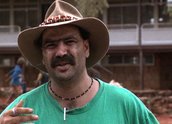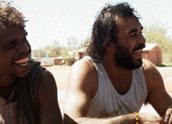

Beating About the Bush (1993)
Synopsis
The rock band Djaambi goes on tour in the Northern Territory visiting remote communities on the way and finishing in Darwin. The Melbourne band is made up of five white and four Indigenous Australians.
The wet conditions make progress difficult and attempts to identify with Northern Territory Aborigines cause more grief than harmony. Relationships within the band and between the band and the filmmakers deteriorate faster than the onset of bad weather.
Curator’s notes
The filmmakers set out to record a music documentary with a happy ending but end up with coverage of a goodwill disaster. They attempt to rescue the film by changing the script midstream and recording the deteriorating situation.
The documentary becomes an interesting social comment where everyone involved can’t or won’t say what they mean, trying to be politically correct. The glaring truth is that if no-one comes to hear you perform then you have a big problem. As painful as the experience was for everyone concerned, the documentary is wryly humorous.
Secondary curator’s notes
by Liz McNivenProduced in 1993, the International Year of Indigenous Peoples, Beating About the Bush stands as an historic document in its subliminal embodiment of the social, cultural and political tensions of the 1990s.
This road movie sets out to document a concert tour by the nine-piece Victorian band Djaambi, led by Richard J Frankland, into remote Aboriginal communities in the Northern Territory. Composed of both Aboriginal and non-Aboriginal musicians, Djaambi, along with other Indigenous bands at the time, helped develop the now established musical touring circuit into remote Indigenous communities across Australia.
The awkwardness and uncertainty of the filmmakers comes across in the unfolding sequence of events. From the start, the film seems to be more about the filmmakers’ own experiences and their relationship with the band than about the band or its tour. This sets the scene for a film at odds with itself and out of sync with its subject.
Reminiscent of the home-movie format, the film mimics adventure travelogues from the 1950s. As with its forebears, this adventure sets out on the well-worn path from Melbourne through central and northern Australia to Darwin. It includes the standard scene of vehicles laden with gear traversing dusty, muddy and boggy dirt roads.
Beating About the Bush doesn’t portray the perspective of its Indigenous characters – rather it contrasts their Aboriginality with the peoples living in these remote communities. In doing so, it reaffirms the archaic notion of the race and caste system, further entrenching the sense of cultural loss suffered by peoples in the south. As the film struggles to articulate itself it begins to lose the plot. By comparison to the docudrama Wrong Side of the Road (1981), about the Aboriginal bands No Fixed Address and Us Mob, Beating About the Bush leaves much to be desired.
Although not captured in the film, I suspect this trip culturally confronted and profoundly affected most of the participants. We don’t really get to know much of the characters in the band or gain any insight into their experience. Band member Allison’s narration seems tacked on as if in an attempt to stitch together a patch-worked storyline. It sounds stiff and scripted rather than a spontaneous response to the culture and environment.
Couched within a colonial framework, it’s no wonder musician Peter Rotumah took issue with the film. He describes it as just another white documentary on Aboriginal people made without any lasting commitment or obligation – more like an impersonal interlude than a meaningful relationship with the people concerned. Maybe this experience highlighted the need for Indigenous filmmakers and inspired the lead singer of Djaambi, Richard J Frankland, to go on to produce and direct film and television.
The restrictions placed on the film crew within the communities highlight Indigenous peoples’ maintenance of their self-determination in controlling access to their domestic and cultural imagery. By the 1990s, Indigenous filmmakers exercised their right to tell their own stories, in their own languages, and in accordance with their own cultural protocols. Self-representation put an end to Indigenous imagery being subject to the mercy, whim or curiosity of others.
In the 1990s, the Australian Film Commission, now Screen Australia, established an Indigenous Branch to fund the professional and creative development of Indigenous filmmakers. Within 20 years this branch has fostered a highly acclaimed and almost critical mass of Indigenous filmmakers.
Beating About the Bush flagged the end of an Australian filmmaking tradition, of non-Indigenous people making films about Indigenous peoples and their cultures, to be superseded by the emergence of Indigenous filmmakers representing themselves, their peoples and cultures on film. This time of transition and change marked a new beginning in Australian filmmaking.




